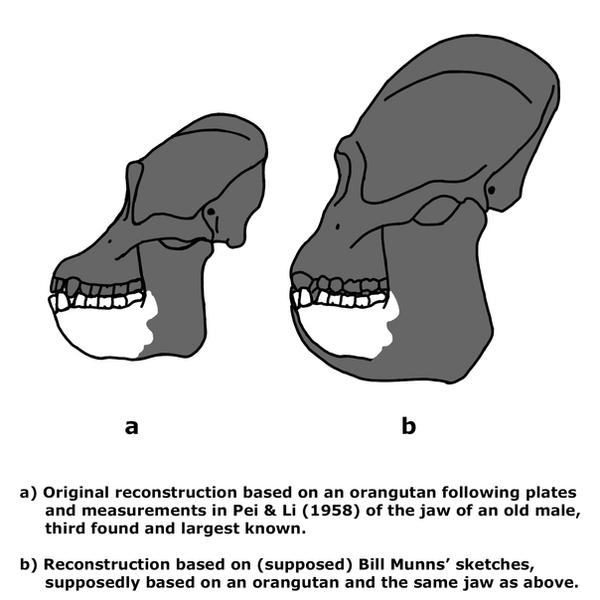Post by Deleted on Apr 5, 2016 1:21:47 GMT 5
Asiatic Black Bear - Ursus thibetanus
The Asiatic Black Bear (Ursus thibetanus), also known as the Tibetan black bear, the Himalayan black bear, or the moon bear, is a medium sized, sharp-clawed, black-coloured bear with a distinctive white or cream "V" marking on its chest. It is a close relative of the American black bear with which it is thought to share a European common ancestor. It grows to approximately 130 to 190 cm (4¼ to 6¼ ft) in length. Males weigh between 110 and 150 kg (240 to 330 lb) and females weigh between 65 to 90 kg (140 to 200 lb). The bear's life span is around 25 years.

Gigantopithecus blacki
Gigantopithecus is an extinct genus of ape that existed from roughly one million years to as recently as three hundred thousand years ago, in what is now China, India, and Vietnam, placing Gigantopithecus in the same time frame and geographical location as several hominin species. The fossil record suggests that individuals of the species Gigantopithecus blacki were the largest apes that ever lived, standing up to 3 metres (9.8 ft). The fossil record suggests that individuals of the species Gigantopithecus blacki were the largest apes that ever lived, standing up to 3 metres (9.8 ft). Due to wide interspecies differences in the relationship between tooth and body size, some argue that it is more likely that Gigantopithecus was much smaller, at roughly 1.8 m (5.9 ft). Recent estimates of its body mass suggest a weight of 200–300 kg (440 - 660 lb). The species lived in Asia and probably inhabited bamboo forests, since its fossils are often found alongside those of extinct ancestors of the panda. Most evidence points to Gigantopithecus being a plant-eater. Its appearance is not known, because of the fragmentary nature of its fossil remains. It is possible that it resembled modern gorillas, because of its supposedly similar lifestyle. Some scientists, however, think that it probably looked more like its closest modern relative, the orangutan. Being so large, it is possible that Gigantopithecus had few or no enemies when fully grown.

The Asiatic Black Bear (Ursus thibetanus), also known as the Tibetan black bear, the Himalayan black bear, or the moon bear, is a medium sized, sharp-clawed, black-coloured bear with a distinctive white or cream "V" marking on its chest. It is a close relative of the American black bear with which it is thought to share a European common ancestor. It grows to approximately 130 to 190 cm (4¼ to 6¼ ft) in length. Males weigh between 110 and 150 kg (240 to 330 lb) and females weigh between 65 to 90 kg (140 to 200 lb). The bear's life span is around 25 years.

Gigantopithecus blacki
Gigantopithecus is an extinct genus of ape that existed from roughly one million years to as recently as three hundred thousand years ago, in what is now China, India, and Vietnam, placing Gigantopithecus in the same time frame and geographical location as several hominin species. The fossil record suggests that individuals of the species Gigantopithecus blacki were the largest apes that ever lived, standing up to 3 metres (9.8 ft). The fossil record suggests that individuals of the species Gigantopithecus blacki were the largest apes that ever lived, standing up to 3 metres (9.8 ft). Due to wide interspecies differences in the relationship between tooth and body size, some argue that it is more likely that Gigantopithecus was much smaller, at roughly 1.8 m (5.9 ft). Recent estimates of its body mass suggest a weight of 200–300 kg (440 - 660 lb). The species lived in Asia and probably inhabited bamboo forests, since its fossils are often found alongside those of extinct ancestors of the panda. Most evidence points to Gigantopithecus being a plant-eater. Its appearance is not known, because of the fragmentary nature of its fossil remains. It is possible that it resembled modern gorillas, because of its supposedly similar lifestyle. Some scientists, however, think that it probably looked more like its closest modern relative, the orangutan. Being so large, it is possible that Gigantopithecus had few or no enemies when fully grown.














